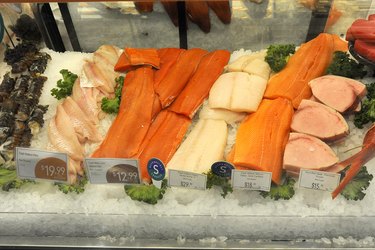
The display case at your local fishmonger or supermarket features white-fleshed fish of various kinds, with halibut arguably the finest of them all. Its lean, delicate flesh becomes firm, mild and perfectly white when cooked, with a moist and succulent texture. The fish can grow to become quite large -- 30 to 500 pounds -- so both steaks and fillet portions tend to be thick and meaty. They'll stand up to the heat of your grill but also work well in more delicate preparations.
Grilled Halibut Steaks or Fillets
Video of the Day
Step 1
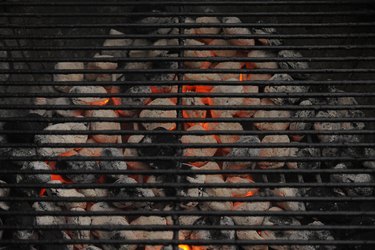
Scrape your grill thoroughly with a wire brush, and wipe away any soot and debris. Oil the grill lightly to help minimize sticking. Light your gas or coals, and bring the grill to a medium-high temperature of about 400 F.
Video of the Day
Step 2
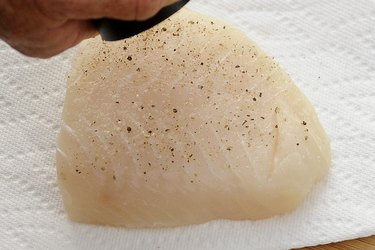
Blot the halibut portions with fresh paper towels to remove any surface moisture. Season them with salt and pepper, or other herbs and spices as you prefer. Brush or spray the fillets lightly with oil or butter.
Step 3
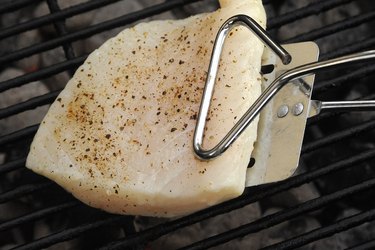
Place your halibut portions carefully on the grill. If you intend to make restaurant-style crosshatched grill marks on each piece, align them at a consistent angle to the grill's bars. After two minutes, when they're well-marked, use a broad spatula to carefully loosen them from the grill and swing them at a 60- to 90-degree angle from their first alignment. This creates the second set of lines for the crosshatch effect.
Step 4
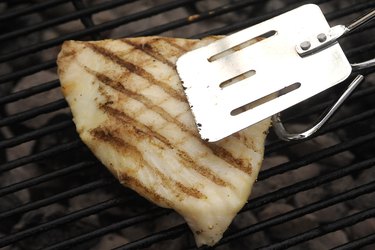
Grill your portions for 4 to 5 minutes total on the first side, then flip them and cook the second side for the same length of time. The halibut is properly cooked when it remains just barely translucent at the thickest point in each portion.
Step 5

Remove your portions from the grill and serve immediately with your favorite side dishes.
Halibut 'En Papillote'
Step 1

Cut a large oblong or square of parchment paper, at least three times as wide as the halibut portions you're using, for each piece of fish. Preheat your oven to 400 degrees Fahrenheit.
Step 2
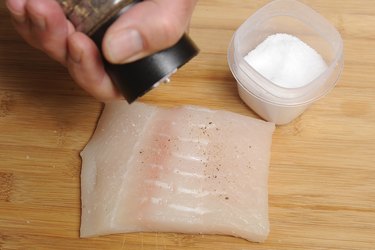
Season the halibut portions with salt and pepper, or other flavoring ingredients as desired.
Step 3
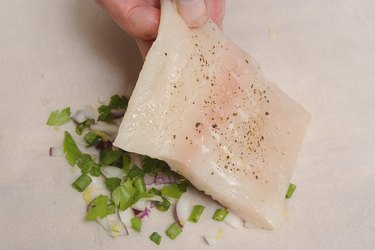
Arrange a small bed of thinly sliced spring onions, fresh herbs, citrus zest or other aromatic ingredients in the middle of your sheets of parchment. Position one halibut portion on top of each bed of aromatics. Lift and match the edges of the parchment together, then crease and fold them to seal each portion of halibut into its own pouch.
Step 4
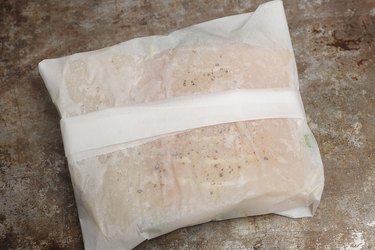
Arrange your portions on a sheet pan, leaving space between them for air to circulate. Slide the sheet pan into your preheated oven.
Step 5
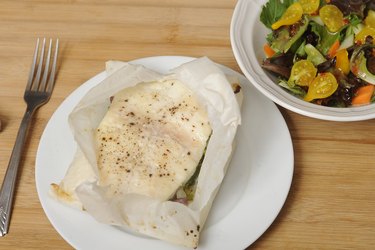
Bake the halibut portions for approximately 15 minutes, until the parchment is browned and puffy. Place one portion on each plate, and carefully snip it open with a pair of well-washed scissors. Not only is it showy, but the aromatic steam escaping from the parcel provides much of the diner's sensory pleasure.
Pan-Seared Halibut
Step 1
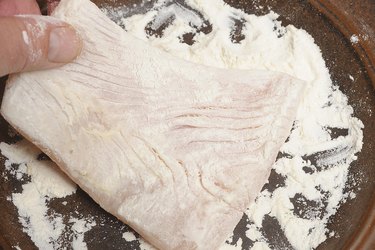
Season your halibut portions generously with salt and pepper, or other flavorings as desired. Dredge them lightly in flour, shaking off any excess. Alternatively, for additional flavor and texture, crust the portions in coarse-ground spices, chopped nuts, or fine seeds such as poppyseed, chia seed or sesame seed.
Step 2
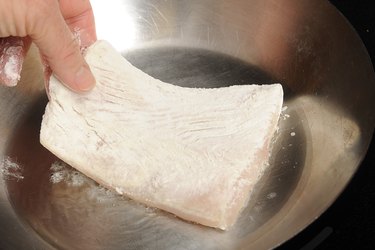
Preheat a heavy skillet over a medium-high burner. Once the pan is well heated and heat shimmers are visible in the air over it, pour in a tablespoon or so of high-temperature oil such as grapeseed or canola. Carefully lower two or three portions into the pan, taking care not to crowd them.
Step 3
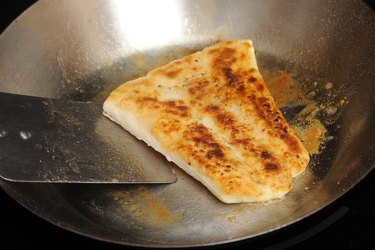
Sear 1-inch portions for approximately 4 to 5 minutes per side, shortening that time for thinner portions and extending it for extra-thick portions. A thick crust, such as crushed pistachios, also lengthens the time needed to cook your halibut by raising the fish away from the direct heat of the pan.
Step 4

Drain the portions briefly on brown paper to blot any excess fat, then serve.
Tip
Leaner than other popular fish such as salmon, halibut does not tolerate overcooking as well. The thickest area of each fillet should just be on the verge of changing from translucent to white when the fish is fully cooked. If it's overcooked, it will become dry, and its delicate flavor will be impaired.
Some parchment-paper manufacturers produce pre-formed pouches for cooking "en papillote." Simply fill the pouch, then fold down the long flap to close it. Place the pouch on your baking sheet with the flap facing down.
Line your sheet pan with aluminum foil to speed cleanup. Some juices will inevitably escape from the parchment pouches, and this prevents them sticking to your pan. In a pinch, if you have no parchment, you can also use foil to enclose your halibut portions.
Pan-seared halibut can also be seared for just 2 minutes per side, to brown the coating, then finished in the same skillet in a 350 F oven. Allow 5 to 7 minutes in the oven for inch-thick fillet portions or steaks. This is an especially useful technique if your favorite crust ingredients are prone to scorching in the pan.
If your fishmonger cuts halibut in-house, rather than receiving it already processed, ask for a bag of heads and "racks," or skeletons. The heads, bones and skin of halibut make an unusually good fish stock for soups and sauces. Remove the gills from the heads first, if present, as they give your broth an unpleasant flavor.
- Fine Cooking: Halibut
- Serious Eats: How to Grill Skinless Fish Fillets or Steaks
- Epicurious: Grilled Halibut with Lemon-Basil Vinaigrette
- Cooking Light: Tasty Packages -- En Papillote Steaming
- MyRecipes.com: Cooking Light -- Lemon-Artichoke Halibut en Papillote
- The Cooking Fishmonger: Cooking Halibut